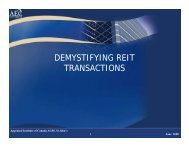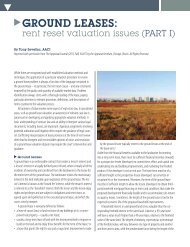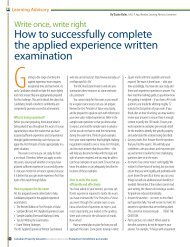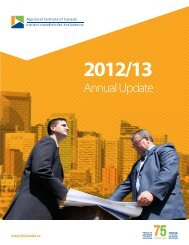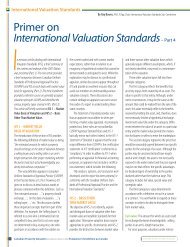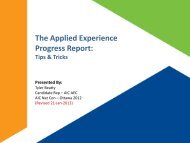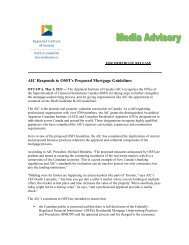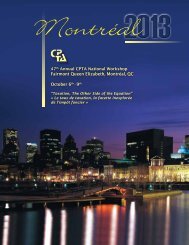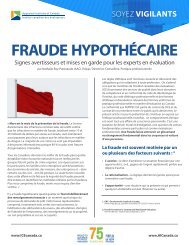Book 1 - Appraisal Institute of Canada
Book 1 - Appraisal Institute of Canada
Book 1 - Appraisal Institute of Canada
Create successful ePaper yourself
Turn your PDF publications into a flip-book with our unique Google optimized e-Paper software.
In some instances, real property assets can be categorized in thefollowing classes:1. Core properties are primarily used to accomplish the operationalpurposes or service-delivery objectives, which could includeimproved properties and/or vacant land, and2. Non-core assets, which are functionally obsolete, near or at theend <strong>of</strong> their economic life, and could be considered as surplusor underutilized. Non-core assets are those properties that areconsidered to be excess to the corporate mission.Benchmarking and performance measurementAs part <strong>of</strong> any effective asset management plan, balancedperformance measures must be in place to ensure that you are beingcompetitive within the marketplace. Benchmarking is a form <strong>of</strong>measurement based on a continuous improvement process that can becompared and measured. This could result in outsourcing/insourcing <strong>of</strong>various functions such as janitorial services, property management, etc.Refurbishment or enhancementThis stage includes a review <strong>of</strong> the owner’s objectives relative to thecurrent market conditions and, completion <strong>of</strong> a cost-benefit analysisby the asset manager. Once completed, one or more <strong>of</strong> the followinganalytical tools can be used:- Net present value (NPV)- Internal rate <strong>of</strong> return (IRR)- Return on investment (ROI)The above analysis may result in several scenarios such as:• status quo,• initiation <strong>of</strong> a change <strong>of</strong> use due to a highest and best useanalysis,• modernization/renovation <strong>of</strong> the property, and• disposition.For additional information on strategic asset planning, reference theobjectives <strong>of</strong> an asset manager as outlined under the Planning phase.DisposalFactors that may contribute to an owner’s decision to sell include:- seller’s market,- improvements are at the end <strong>of</strong> their economic life,- major life-cycle work,- change in ownership strategy such as a lease to <strong>of</strong>fer moreflexibility, and- need for cash or liquidity.Similar to the acquisition phase, the ownership would typicallycomplete its own due diligence analysis before the disposal. Someitems that may be considered at this time are:- commissioning an appraisal,- confirmation <strong>of</strong> market conditions and business cycle,- review <strong>of</strong> leases including rents and operating costs,- obtainment <strong>of</strong> estoppel certificates,- title search to ensure that there are no surprises,- requirement for life-cycle work, and- completing a Phase I Environmental Site Assessment.The ownership must also determine whether or not they are preparedto sell the property ‘as is, where is’ or, alternatively, what warrantiesand representations they are prepared to accept. There could also beconsideration as to whether or not there are any outstanding workorders or restrictions on title such as easements and covenants thatwould need to be addressed.With respect to a marketing strategy, the type <strong>of</strong> property, marketcycle, method <strong>of</strong> sale and geographic location are all examples <strong>of</strong>factors that require consideration. For commercial properties, potentialpurchasers will be interested in the tenant mix, quality <strong>of</strong> tenant andcontract rents, which are all components <strong>of</strong> the ‘quantity’ and ‘quality’<strong>of</strong> income.There are a number <strong>of</strong> options that an owner can choose fordisposal such as listing with a real estate broker, direct sale, auctionand tender.ConclusionThe primary focus <strong>of</strong> asset management is the creation <strong>of</strong> value toachieve owner objectives. In the real estate ownership cycle, thisprocess begins with understanding the owner’s objectives, planning,and moving through the acquisition phase; it continues throughthe operation and maintenance phase, and the refurbishment andenhancement phase; and, finally, ends with the disposition <strong>of</strong> the asset.Due to the complexities <strong>of</strong> asset management, it is also important tohave strategic pr<strong>of</strong>essional staff overseeing this mandate on behalf <strong>of</strong>the ownership.For additional information on asset management, the BOMI<strong>Institute</strong> <strong>of</strong>fers a four-day course and the IRWA <strong>of</strong>fers aone-day course.References1Asset Management, BOMI <strong>Institute</strong>, Defining Real Estate AssetManagement, pg. 1-22Queensland Government Government <strong>of</strong> Works www.build.qld.gov.au/downloads/bpu/sam_overview.pdf3Corporate Property Management: Aligning Real Estate with BusinessStrategy, by Victoria Edwards and Louise Ellison, pg. 44Brookfield Properties http://investors.brookfieldproperties.com/phoenix.zhtml?c=91790&p=irol-irhome5The Handbook <strong>of</strong> Commercial Real Estate Investing, John McMahan,McGraw-Hill, 2006, pg. 1646Wikipedia http://en.wikipedia.org/wiki/Whole-life_costclick here to return to table <strong>of</strong> contentsCanadian Property Valuation Volume 54 | book 1 | 2010 Évaluation Immobilière au <strong>Canada</strong> 45



